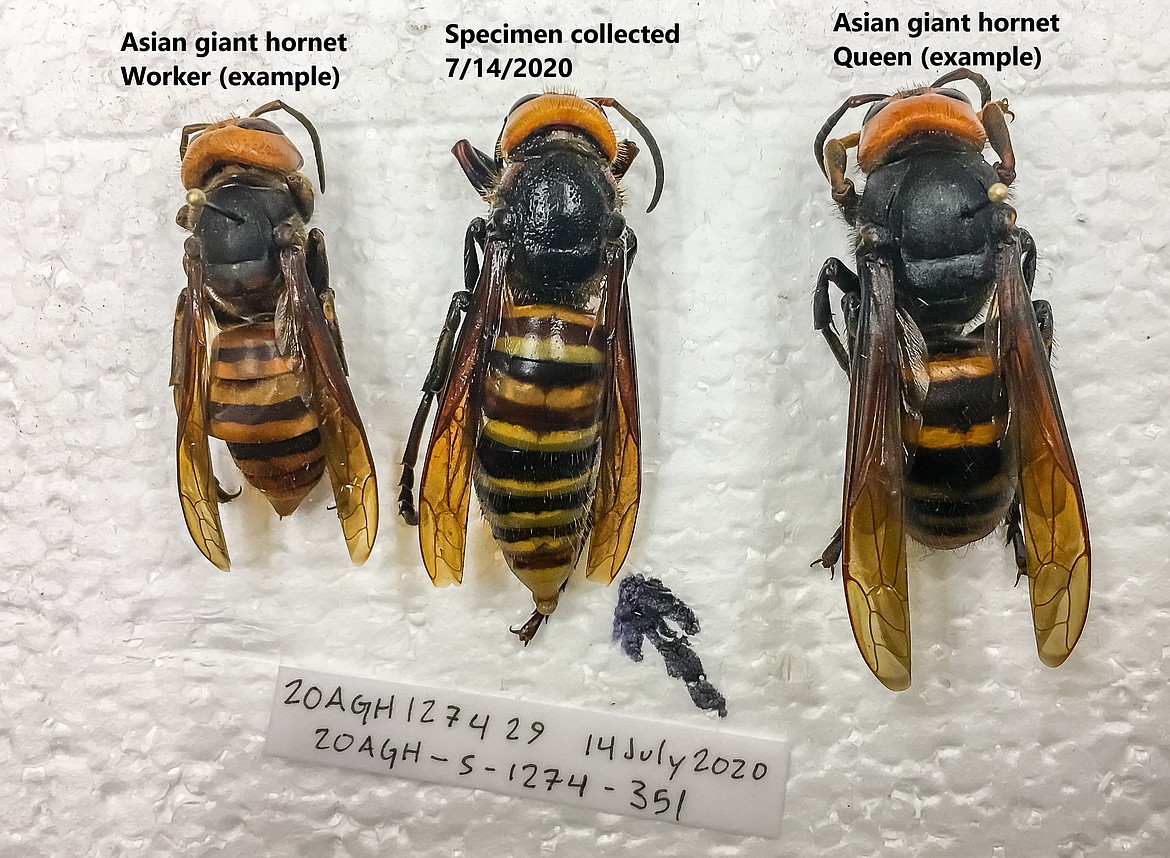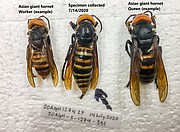State agriculture department catches first Asian giant hornet
BIRCH BAY — Researchers with the Washington State Department of Agriculture (WSDA) trapped their first Asian giant hornet earlier this month.
According to Erik-Sven Spichiger, managing entomologist for the department, the insect, informally called a “murder hornet” for its ability to destroy honeybee hives, was caught in a WSDA trap near Birch Bay in Whatcom County.
“This is not unexpected; we knew there was a nest,” he said during a press conference the morning of Friday, July 31.
Spichiger said it was identified as an Asian giant hornet, but WSDA researchers did not know if it was a worker or a queen, because its size put it in between the two. The insect has been sent to a U.S. Department of Agriculture lab in Washington, D.C., to determine whether the specimen was a worker or queen.
“I’m tending toward it being a worker, since you don’t generally see queens out this time of year,” he said.
Queens, Spichiger added, are usually busy laying eggs for new workers, drones and queens in the insect’s underground colonies.
This is the sixth Asian giant hornet found in Washington since early December 2019, in the far northwest corner of the state. The hornets, which average 1.5-2 inches in length and prey upon smaller insects, focus on bee hives, which a group of giant hornets can destroy in as little as 90 minutes. In Japan, honey bees have evolved a defense against hornet scouts — they surround the hornet in a tight ball and both suffocate it with exhaled carbon dioxide and cook it with their body heat.
European honeybees, however, have no defense against the Asian giant hornet.
No one is entirely sure how the Asian giant hornet, which was first seen in Canada in September 2019, got to the United States, though it is believed to have inadvertently hitched a ride on a cargo ship.
Spichiger said WSDA has deployed nearly 500 traps, mostly in Whatcom County, to catch Asian giant hornets, with another 300 set up by private agencies and more than 1,000 traps put up by the public.
WSDA hopes to find and destroy the nest by September, before any queens can found new colonies, Spichiger said. Tracking involves searching the area for a nest or catching a live hornet in a trap, gluing a tiny GPS tracker or a camera to the insect’s back and following the signal or the trail back to the nest.
“The typical foraging flight range is within two kilometers,” Spichiger said. “They go up to eight kilometers, but there’s a greater likelihood of the nest being within one to two kilometers of where we trapped the insect.”
According to guidelines developed by WSDA and the USDA’s Animal and Plant Health Inspection Service (APHIS), state workers will seal the entrance of the underground nest and then pump it full of either the common pesticide cyfluthrin or carbon dioxide gas to kill all the hornets. According to the protocol, the nest must then be dug up and removed, with workers revisiting the site 24 hours later to see if they got everything. If carbon dioxide is used to kill the insects, APHIS mandates all dead hornets must be in ethanol.
Spichiger said workers eradicating the nests must wear very thick protective clothing to guard against the hornets’ one-quarter-inch-long stingers, as well as to ensure that most of the hornets they want to kill are in their nest.
“We’ll also turn on red lamps, so we can see what we’re doing, but the hornets cannot,” he said. “That protects us a little and gives us an advantage they don’t have.”
If you think you see an Asian giant hornet, report it to the Washington State Department of Agriculture at agr.we.gov/hornets or contact the pest program at 1-800-443-6684.
Charles H. Featherstone can be reached at [email protected].




